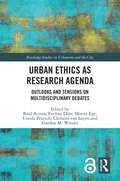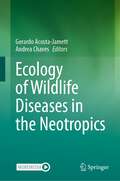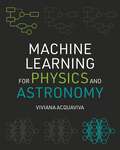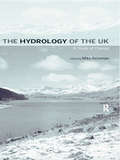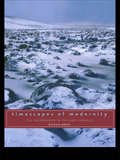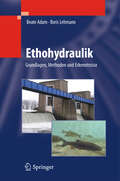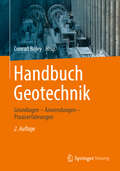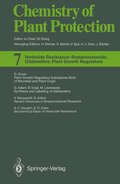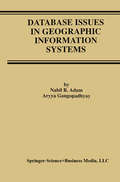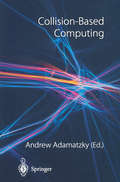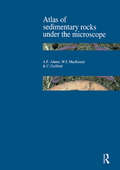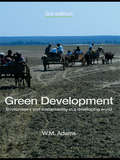- Table View
- List View
Urban Ethics as Research Agenda: Outlooks and Tensions on Multidisciplinary Debates (Routledge Studies in Urbanism and the City)
by Raúl Acosta Eveline Dürr Moritz Ege Ursula Prutsch Clemens Van Loyen Gordon M. WinderThis book provides an outline for a multidisciplinary research agenda into urban ethics and offers insights into the various ways urban ethics can be configured. It explores practices and discourses through which individuals, collectives and institutions determine which developments and projects may be favourable for dwellers and visitors traversing cities. Urban Ethics as Research Agenda widens the lens to include other actors apart from powerful individuals or institutions, paying special attention to activists or civil society organizations that express concerns about collective life. The chapters provide fresh perspectives addressing the various scales that converge in the urban. The uniqueness of each city is, thus, enriched with global patterns of the urban. Local sociocultural characteristics coexist with global flows of ideas, goods and people. The focus on urban ethics sheds light on emerging spaces of human development and the ways in which ethical narratives are used to mobilize and contest them in terms of the good life. This timely book analyses urban ethical negotiations from social and cultural studies, particularly drawing on anthropology, geography, and history. This volume will be of interest to scholars, researchers and practitioners interested in ethics and urban studies.
Ecology of Wildlife Diseases in the Neotropics
by Gerardo Acosta-Jamett Andrea ChavesThis contributed volume focuses on the Neotropical region, and explores the environmental, ecological and socio-economic components that facilitate the emergence of zoonotic diseases. This book highlights the primary ecological, environmental, social, and economic variables associated with the risk of maintenance, transmission, and dissemination of emerging, re-emerging, and neglected infectious diseases, in which Neotropical vertebrates are involved. It compiles up-to-date knowledge and research for the neotropical region, as well as discusses the current needs of knowledge improvement. The chapters include various examples of the cycles of infectious diseases, all with world-wide relevance where neotropical wild vertebrates are affected or involved.
Machine Learning for Physics and Astronomy
by Viviana AcquavivaA hands-on introduction to machine learning and its applications to the physical sciencesAs the size and complexity of data continue to grow exponentially across the physical sciences, machine learning is helping scientists to sift through and analyze this information while driving breathtaking advances in quantum physics, astronomy, cosmology, and beyond. This incisive textbook covers the basics of building, diagnosing, optimizing, and deploying machine learning methods to solve research problems in physics and astronomy, with an emphasis on critical thinking and the scientific method. Using a hands-on approach to learning, Machine Learning for Physics and Astronomy draws on real-world, publicly available data as well as examples taken directly from the frontiers of research, from identifying galaxy morphology from images to identifying the signature of standard model particles in simulations at the Large Hadron Collider.Introduces readers to best practices in data-driven problem-solving, from preliminary data exploration and cleaning to selecting the best method for a given taskEach chapter is accompanied by Jupyter Notebook worksheets in Python that enable students to explore key conceptsIncludes a wealth of review questions and quizzesIdeal for advanced undergraduate and early graduate students in STEM disciplines such as physics, computer science, engineering, and applied mathematicsAccessible to self-learners with a basic knowledge of linear algebra and calculusSlides and assessment questions (available only to instructors)
The Hydrology of the UK: A Study of Change (Routledge Environmental Management)
by Mike AcremanThe Hydrology of the UK assesses the changing hydrology of the UK, focusing on key issues that affect the fundamental hydrological processes and have important implications for water resource management, flood risk and environmental quality. The bookis divided into 3 sections: Section 1 examines the causes of change to the hydrology of the UK, including the impact of climate change, land use and geomorphological change, and dam construction. Section 2 assesses the effects of these pressures on UK rivers, goundwater, lakes, ponds, reservoirs and wetlands, looking at water quality, degradation, pollution and protection. Section 3 examines the responses of goverment organisations responsible for planning and management of water, including Environment Agencies, British Hydrological Society and the growing urgency for a World Hydrology Initiative.Change will continue to be a major feature of UK hydrology in the future. This book provides an understanding of the changing hydrology of the UK and the international scene today and looks to the needs for the future.
The Hydrology of the UK: A Study of Change (Routledge Environmental Management)
by Mike AcremanThe Hydrology of the UK assesses the changing hydrology of the UK, focusing on key issues that affect the fundamental hydrological processes and have important implications for water resource management, flood risk and environmental quality. The bookis divided into 3 sections: Section 1 examines the causes of change to the hydrology of the UK, including the impact of climate change, land use and geomorphological change, and dam construction. Section 2 assesses the effects of these pressures on UK rivers, goundwater, lakes, ponds, reservoirs and wetlands, looking at water quality, degradation, pollution and protection. Section 3 examines the responses of goverment organisations responsible for planning and management of water, including Environment Agencies, British Hydrological Society and the growing urgency for a World Hydrology Initiative.Change will continue to be a major feature of UK hydrology in the future. This book provides an understanding of the changing hydrology of the UK and the international scene today and looks to the needs for the future.
Public Policy in an Entrepreneurial Economy: Creating the Conditions for Business Growth (International Studies in Entrepreneurship #17)
by Zoltan J. Acs Roger R. StoughThis unique volume presents policy recommendations designed to promote entrepreneurship. It considers timely issues like impact of securities regulation, educational policy and intellectual property protection on entrepreneurship. In the process, the book addresses policies operating at the individual, national, regional, and international levels, and offers a unique perspective on several institutional structures that enhance entrepreneurship and economic growth.
Global City Challenges: Debating a Concept, Improving the Practice
by M. Acuto W. SteeleThe contributors illustrate what twin analytical and practical challenges emerge from juxtaposing cultural, economic, historical, postcolonial, virtual, architectural, literary, security and political stances to the concept of the 'global city'.
Investigating Groundwater (IAH - International Contributions to Hydrogeology #29)
by Ian AcworthInvestigating Groundwater provides an integrated approach to the challenges associated with locating groundwater. Uniquely, the book provides a review of the wide range of techniques that can be deployed to investigate this important resource. Many of the practical examples given are based upon Australian experience but the methods have worldwide applicability. The book is published in colour and includes many original diagrams and photographs. Particular effort has been made to provide consistent terminology and SI units are used throughout the text Investigating Groundwater starts with an introduction to the historical significance of groundwater and gives an account of climate change. A description of the occurrence of groundwater in different rock types is then provided. A detailed account of surface water techniques is then followed by an account of the interconnections between surface water and groundwater. Four chapters describing groundwater hydraulics are then followed by four chapters describing the latest geophysical techniques. Once the best location of a borehole is determined using these techniques; chapters then describe appropriate drilling methods to use; provide a wide ranging review of geophysical logging, hydrochemical and isotopic techniques, before concluding with a detailed description of groundwater flow to a well. Written for a worldwide audience of degree level geology/engineering practitioners, academics and students involved in groundwater resource investigation methods; Investigating Groundwater is essential reading for those involved in groundwater research. Key Features: Presents the theoretical background and a detailed description of the techniques used in the investigation of groundwater. Describes the general occurrence of groundwater in different rock types; surface water hydrology and interconnected surface and groundwater systems. Provides detailed descriptions of geophysical techniques (seismic, electrical, gravity and heat) and an account of available geophysical logging methods. Reviews hydrochemical and isotope methods, followed by an account of drilling techniques. Gives a detailed account of radial flow to a well, including appropriate modelling and pump-testing techniques and a consideration of non-linear flow. Of interest to anyone involved in the development of groundwater resources, either for domestic supply, for agriculture or for mining.
Investigating Groundwater (IAH - International Contributions to Hydrogeology #29)
by Ian AcworthInvestigating Groundwater provides an integrated approach to the challenges associated with locating groundwater. Uniquely, the book provides a review of the wide range of techniques that can be deployed to investigate this important resource. Many of the practical examples given are based upon Australian experience but the methods have worldwide applicability. The book is published in colour and includes many original diagrams and photographs. Particular effort has been made to provide consistent terminology and SI units are used throughout the text Investigating Groundwater starts with an introduction to the historical significance of groundwater and gives an account of climate change. A description of the occurrence of groundwater in different rock types is then provided. A detailed account of surface water techniques is then followed by an account of the interconnections between surface water and groundwater. Four chapters describing groundwater hydraulics are then followed by four chapters describing the latest geophysical techniques. Once the best location of a borehole is determined using these techniques; chapters then describe appropriate drilling methods to use; provide a wide ranging review of geophysical logging, hydrochemical and isotopic techniques, before concluding with a detailed description of groundwater flow to a well. Written for a worldwide audience of degree level geology/engineering practitioners, academics and students involved in groundwater resource investigation methods; Investigating Groundwater is essential reading for those involved in groundwater research. Key Features: Presents the theoretical background and a detailed description of the techniques used in the investigation of groundwater. Describes the general occurrence of groundwater in different rock types; surface water hydrology and interconnected surface and groundwater systems. Provides detailed descriptions of geophysical techniques (seismic, electrical, gravity and heat) and an account of available geophysical logging methods. Reviews hydrochemical and isotope methods, followed by an account of drilling techniques. Gives a detailed account of radial flow to a well, including appropriate modelling and pump-testing techniques and a consideration of non-linear flow. Of interest to anyone involved in the development of groundwater resources, either for domestic supply, for agriculture or for mining.
Physics and Engineering Applications of Magnetism (Springer Series in Solid-State Sciences #92)
by K. Adachi S. Chikazumi E. Hirota N. Imamura Y. Ishikawa Y. Makino N. Miura T. Mizoguchi Y. Nakamura Y. Sugita K. Tajima M. Takahashi A. Tonomura T. WakiyamaThis book was originally published in Japanese in honour of Professor S. Chikazumi on the occasion of his retirement from the University of Tokyo in March 1982. Physicists who had been supervised by him or had closely col laborated with him wrote articles on recent developments in magnetism and its engineering applications. In the preface of his excellent textbook Physics of Magnetism (Wiley, 1964), Professor Chikazumi says that recent research in magnetism deals with fundamental physical problems and, at the same time, with more secondary magnetic phenomena, as well as with engineering applications of magnetic materials to electromagnetic machines, permanent magnets and electronic computers, and that the purpose of his textbook is to give a general view of these magnetic phenomena, focusing its main interest at the center of such a broad field. Always keeping such a viewpoint in mind, Professor Chikazumi has contributed a great deal to both fundamental physics and applications of magnetism. This is described in Chap. 1 of this book. Many books have been published on both the physics and applications of magnetism. However, no single book has a viewpoint covering both of them. The recent development of high technology needs such a broad viewpoint for scientists and engineers since it is a product of both fundamental science and technology. Research in magnetism is based on the response which materials show to the application of magnetic fields.
Timescapes of Modernity: The Environment and Invisible Hazards
by Barbara AdamTimescapes of Modernity explores the relationship between time and environmental and socio-cultural concerns. Using examples such as the BSE crisis, the Sea Empress oil pollution and the Chernobyl radiation Barbara Adam argues that environmental hazards are inescapably tied to the successes of the industrial way of life. Global markets and economic growth; large-scale production of food; the speed of transport and communication; the 24 hour society and even democratic politics are among the invisible hazards we face. With this unique 'timescape' perspective the author dislodges assumptions about environmental change, enables a rethinking of environmental problems and provides the potential for new strategies to deal with environmental hazards.
Timescapes of Modernity: The Environment and Invisible Hazards (Global Environmental Change Ser.)
by Barbara AdamTimescapes of Modernity explores the relationship between time and environmental and socio-cultural concerns. Using examples such as the BSE crisis, the Sea Empress oil pollution and the Chernobyl radiation Barbara Adam argues that environmental hazards are inescapably tied to the successes of the industrial way of life. Global markets and economic growth; large-scale production of food; the speed of transport and communication; the 24 hour society and even democratic politics are among the invisible hazards we face. With this unique 'timescape' perspective the author dislodges assumptions about environmental change, enables a rethinking of environmental problems and provides the potential for new strategies to deal with environmental hazards.
Ethohydraulik: Grundlagen, Methoden und Erkenntnisse
by Beate Adam Boris LehmannUm Fließgewässer den Nutzungsansprüchen des Menschen anzupassen, sind unzählige Baumaßnahmen erforderlich. Um die Auswirkungen wasserbaulicher Aktivitäten auf die in Fließgewässern lebenden Tiere zu untersuchen, wurde die Ethohydraulik entwickelt. Sie beruht auf der Ethologie (Erforschung des Verhaltens von Tieren) und der Hydraulik (Lehre von den bewegten Flüssigkeiten). Die Autoren stellen die Grundlagen dieser Wissenschaftsdisziplin dar und liefern Regeln sowie Grenz- und Bemessungswerte für die wasserbauliche Praxis.
Ethohydraulics: A Method for Nature-Compatible Hydraulic Engineering (essentials)
by Beate Adam Boris Lehmann Ulrich Schwevers Katharina Bensing Jeffrey A. TuhtanEthohydraulics is the transdiscipline linking behavioural science (ethology) and flow behaviour (hydraulics). Ethohydraulic studies provide repeatable and scalable insights into the reactive behaviour of aquatic animals. The findings can be used to derive limits and guidelines as well as design specifications for the planning of hydraulic engineering facilities. In this essential book, the authors provide an overview of the fundamentals and methodological approaches of ethohydraulic investigations. In addition to real-world case studies, current developments and future advances are provided.This Springer essential is a translation of the original German 1ststedition essentials,Ethohydraulik by Boris Lehmann, published by Springer-Verlag GmbH Germany, part of Springer Nature in 2021. The translation was done with the help of artificial intelligence (machine translation by the service DeepL.com). A subsequent human revision was done primarily in terms of content, so that the book will read stylistically differently from a conventional translation. Springer Nature works continuously to further the development of tools for the production of books and on the related technologies to support the authors.
Handbuch Geotechnik: Grundlagen – Anwendungen – Praxiserfahrungen
by Dietmar Adam Conrad Boley Kurt-Michael Borchert Roland Börger Gebhard Dausch Klaus Englert Winfried Entenmann Helmut Ferrari Yashar Forouzandeh Bastian Fuchs Johannes Giere Alfred Haack Fabian Kirsch Werner Lienhart Roman Marte Claas Meier Jens Mittag Karl Morgen Monika Paulus-Grill Florian Scharinger Bernd Schuppener Sonja Seegert Philipp Siebert Siegfried Stelzig Ulrich Trunk Edelbert Vees Paul Waibel Jimmy Wehr Lisa Wilfing Jörg Zimbelmann Yazhou ZouDas Handbuch Geotechnik ist das Nachschlagewerk aus der Praxis für die tägliche Arbeit des Bauingenieurs und Architekten zu allen Fragen Rund um die Themen Grundbau und Bodenmechanik. Wie werden Böden klassifiziert? Wie kommt man zu einer Bettungsziffer? Welche Lastfälle sind im Deichbau maßgebend? Auf was ist bei der Ausschreibung einer Bohrpfahlgründung zu achten? Umfangreiche Informationen werden für die Anwendung strukturiert aufbereitet, hierbei werden auch Erfahrungswerte mitgeteilt. Grundlagen werden übersichtlich erläutert, die bodenmechanischen Hintergründe werden dabei streng beachtet. Materialmodelle werden so dargestellt, dass die Ermittlung ihrer Parameter aus Laborversuchen nachvollzogen werden kann. Die konzeptionelle Ausrichtung ist anwendungsorientiert, das Werk vermittelt das Fachwissen von Geotechnik-Ingenieuren für Ausbildung und Praxis.Neu in der 2. Auflage: Wesentliche Erweiterung des Themas Baugruben in einem neuen Kapitel, Behandlung der Schlitzwandstatik im Kapitel Geotechnische Bauverfahren, Umstellung auf die europäische Normung, Aktualisierte Rechtsprechung
Geophysics in Mining and Environmental Protection (GeoPlanet: Earth and Planetary Sciences)
by Adam F. Idziak and Ryszard DubielThis book contains contributions to the 32nd Polish-Czech-Slovak Symposium on Mining and Environmental Geophysics held in May 2009 in Piechowice (Poland). The papers are related to various aspects of geophysical science such as induced seismicity, engineering seismology, environmental geophysics and geophysics in geology
Herbicide Resistance — Brassinosteroids, Gibberellins, Plant Growth Regulators (Chemistry of Plant Protection #7)
by G. Adam S. O. Duke D. Gross M. Lischewski V. Marquardt K. C. Vaughn B. VoigtChemistry of Plant Protection, Volume 7, provides critical review articles on new aspects of herbicide resis- tance, serving the needs of research scientists, pesticide manufacturers, government regulators, agricultural practitioners.
Vistas for Geodesy in the New Millennium: IAG 2001 Scientific Assembly, Budapest, Hungary, September 2-7, 2001 (International Association of Geodesy Symposia #125)
by Jozsef Adam Klaus-Peter SchwarzIt was in September 1906 that the predecessor of the IAG, the 'Internationale Erdmessung', th organized the 15 General Assembly at the Hungarian Academy of Sciences in Budapest. It was 95 years later, in September 2001, that the IAG returned to this beautiful city to hold its Scientific Assembly, IAG 2001, in the historical premises of the Academy. The meeting took place from September 2-7, 2001 and continued the tradition of Scientific Assemblies, started in Tokyo (1982) and continued in Edinburgh (1989), Beijing (1993) and Rio de Janeiro (1997). Held every four years at the midpoint between General Assemblies of the IAG, they focus on giving an integrated view of geodesy to a broad spectrum of researchers and practitioners in geodesy and geophysics. The convenient location of the main building of the Hungarian Academy in downtown Budapest and the superb efforts of the Local Organizing Committee contributed in a major way to the excellent atmosphere of the meeting. As at previous meetings, the scientific part of the program was organized as a series of symposia which, as a whole, gave a broad overview of actual geodetic research activities. To emphasize an integrated view of geodesy, the symposia did not follow the pattern of the IAG Sections, but focussed on current research topics to which several IAG Sections could contribute. Each symposium had 5 sessions with presented papers and poster sessions on two consecutive days.
Database Issues in Geographic Information Systems (Advances in Database Systems #6)
by Nabil R. Adam Aryya GangopadhyayGeographic Information Systems (GIS) have been experiencing a steady and unprecedented growth in terms of general interest, theory development, and new applications in the last decade or so. GIS is an inter-disciplinary field that brings together many diverse areas such as computer science, geography, cartography, engineering, and urban planning. Database Issues in Geographic Information Systems approaches several important topics in GIS from a database perspective. Database management has a central role to play in most computer-based information systems, and is expected to have an equally important role to play in managing information in GIS as well. Existing database technology, however, focuses on the alphanumeric data that are required in business applications. GIS, like many other application areas, requires the ability to handle spatial as well as alphanumeric data. This requires new innovations in data management, which is the central theme of this monograph. The monograph begins with an overview of different application areas and their data and functional requirements. Next it addresses the following topics in the context of GIS: representation and manipulation of spatial data, data modeling, indexing, and query processing. Future research directions are outlined in each of the above topics. The last chapter discusses issues that are emerging as important areas of technological innovations in GIS. Database Issues in Geographic Information Systems is suitable as a secondary text for a graduate level course on Geographic Information Systems, Database Systems or Cartography, and as a reference for researchers and practitioners in industry.
Mineral Deposits at the Beginning of the 21st Century
by Adam Piestrzyński et alThe Joint 6th Biennial SGA-SEG Meeting was held in Krakow in August 2001. This volume contains 274 extended abstracts, grouped thematically under 18 session titles covering topics such as lead-zinc deposits; metamorphism affecting mineral deposits; and the environmental aspects of mining.
Collision-Based Computing
by Andrew AdamatzkyCollision-Based Computing presents a unique overview of computation with mobile self-localized patterns in non-linear media, including computation in optical media, mathematical models of massively parallel computers, and molecular systems. It covers such diverse subjects as conservative computation in billiard ball models and its cellular-automaton analogues, implementation of computing devices in lattice gases, Conway's Game of Life and discrete excitable media, theory of particle machines, computation with solitons, logic of ballistic computing, phenomenology of computation, and self-replicating universal computers. Collision-Based Computing will be of interest to researchers working on relevant topics in Computing Science, Mathematical Physics and Engineering. It will also be useful background reading for postgraduate courses such as Optical Computing, Nature-Inspired Computing, Artificial Intelligence, Smart Engineering Systems, Complex and Adaptive Systems, Parallel Computation, Applied Mathematics and Computational Physics.
Affine, Vertex and W-algebras (Springer INdAM Series #37)
by Dražen Adamović Paolo PapiThis book focuses on recent developments in the theory of vertex algebras, with particular emphasis on affine vertex algebras, affine W-algebras, and W-algebras appearing in physical theories such as logarithmic conformal field theory. It is widely accepted in the mathematical community that the best way to study the representation theory of affine Kac–Moody algebras is by investigating the representation theory of the associated affine vertex and W-algebras. In this volume, this general idea can be seen at work from several points of view. Most relevant state of the art topics are covered, including fusion, relationships with finite dimensional Lie theory, permutation orbifolds, higher Zhu algebras, connections with combinatorics, and mathematical physics. The volume is based on the INdAM Workshop Affine, Vertex and W-algebras, held in Rome from 11 to 15 December 2017. It will be of interest to all researchers in the field.
Atlas of Sedimentary Rocks Under the Microscope
by A. E. Adams W. S. Mackenzie C. GuilfordProvides a very clear guide to sedimentary rock types as seen under the microscope supported by practical aspects of slide preparation.
Atlas of Sedimentary Rocks Under the Microscope
by A. E. Adams W. S. Mackenzie C. GuilfordProvides a very clear guide to sedimentary rock types as seen under the microscope supported by practical aspects of slide preparation.
Green Development: Environment and Sustainability in a Developing World
by Bill AdamsThe concept of sustainability lies at the core of the challenge of environment and development and the way governments, business and environmental groups respond to it. Green Development provides a clear and coherent analysis of sustainable development in both theory and practice. This third edition retains the clear and powerful argument of previous editions, but has been updated to reflect advances in ideas and changes in international policy. Greater attention has been given to political ecology, environmental risk and the environmental impacts of development. This fully revised third edition discusses: the origins of thinking about sustainability and sustainable development and its evolution to the present day the ideas that dominate mainstream sustainable development (ecological modernization, market environmentalism and environmental economics) the nature and diversity of alternative ideas about sustainability that challenge ‘business as usual’ thinking (for example ecosocialism, ecofeminism, deep ecology and political ecology) the dilemmas of sustainability in the context of dryland degradation, deforestation, biodiversity conservation, dam construction and urban and industrial development the nature of policy choices about the environment and development strategies and between reformist and radical responses to the contemporary global dilemmas. Green Development offers clear insights into the challenges of environmental sustainability and social and economic development. It is unique in offering a synthesis of theoretical ideas on sustainability and in its coverage of the extensive literature on the environment and development around the world. This book has proved its value to generations of students as an authoritative, thought-provoking and readable guide to the field of sustainable development.
